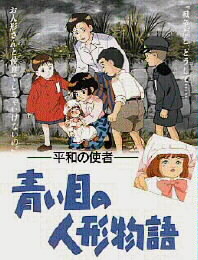|
In 1995, we reached the 50-year anniversary of
the end of World War II. On this occasion, as we remember once again the tragedy
of war and make a fresh resolve for lasting peace, we in Saitama prefecture
decided to carry out some suitable commemoration projects to move toward the
realization of peace in the world and in our tranquil home Saitama. The making of this original
animation movie "The Story of the Blue-eyed Doll" is one of these.
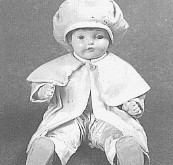 Blue-eyed
Dolls Blue-eyed
Dolls
In the midst of
deteriorating Japan-US relations, pro-Japanese missionary Dr. Sidney Lewis
Gulick and Eiichi Shibusawa became leaders in planning for an exchange of
mutual friendship through dolls. The Blue-eyed
Dolls were given to Japan to try to deepen the understanding and friendship
between the citizens of both countries, and they were "Friendship
Ambassadors of Peace" from America who embodied the feelings of goodwill
of the American people.
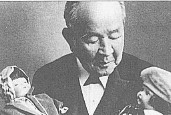 However,
when
World War II started, throughout the country there
were many who suffered the sad fate of being burned or destroyed as enemy dolls. However,
when
World War II started, throughout the country there
were many who suffered the sad fate of being burned or destroyed as enemy dolls.
This movie, set in the harsh environment of
wartime, depicts a warped society caused by war, shows the common
people's suffering, and presents the tragedy of war and the preciousness of
peace through children's actions and through the
Blue-eyed Dolls regarded as the enemy.
Outline
of Story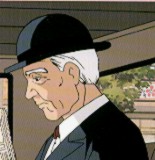
One day in 1929, an old man was
riding in a car going through the center of the city. This person was
Eiichi Shibusawa, a Saitama Prefecture native who worked for modern Japan's
industrial development and international friendship.
Eiichi, while seeing the military
forming ranks and marching, took a photo from his pocket. "Gulick, Japan
appears to be entering bad times," he said in a low voice.
Gulick was the person who offered to Japan
to give "Blue-eyed Dolls" to try to maintain the bonds between Japan
and America as the situation was growing worse.
Eiichi murmured to Gulick in the photo,
"It would be nice if dolls might stop us from entering these cruel times,
but . . ."
In 1937, war broke out between Japan and China, and
Japan went headlong into an all-out war with China.
Also, with the total militarism in 1943,
a dark shadow was gathering over the children at Osawa National School in
Koshigaya in Saitama prefecture.
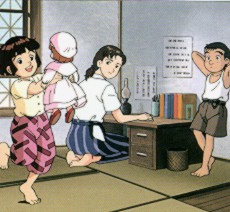 Next
to the teachers' room at one end of the schoolhouse, there was a small room. Next
to the teachers' room at one end of the schoolhouse, there was a small room.
Today, the new woman teacher, Yoshie Tanaka,
was grading the children's papers there.
Next to her, her students Chika Watera
and her friend Kota Saito were playing.
Chika found and
opened up a small box.
"Oh, cute!"
It was a Blue-eyed Doll that had been given by America when Mrs. Tanaka was a sixth-grade student.
Chika knew that the doll's name Martha was
similar to her own name, and she liked her more and more.
With
tears in her eyes, Mrs. Tanaka talked about the
situations in which the doll had been placed from those days until now, and she said,
"Even the doll is miserable in
times like these." But she made them promise not to say anything to
others about these things.
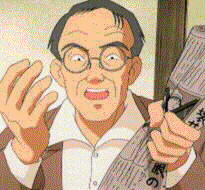 The
war situation grew worse day by day, and it reached the point where children
used wooden swords to strike straw dolls with drawings of the faces of
Churchill and Roosevelt attached to them, and they received training to fight
with bamboo spears. The
war situation grew worse day by day, and it reached the point where children
used wooden swords to strike straw dolls with drawings of the faces of
Churchill and Roosevelt attached to them, and they received training to fight
with bamboo spears.
One day Chika secretly invited her
classmate Tamae, who had lost her parents and had been evacuated from
the city, and showed her the Blue-eyed Doll in the small room. However, they
were discovered by the vice-principal, and the existence of the Blue-eyed Doll
become known. 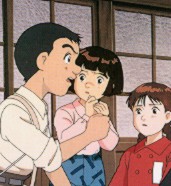 The school's staff soon called a meeting to discuss the matter. The school's staff soon called a meeting to discuss the matter.
At the meeting of the school's staff, a highly
agitated discussion broke out concerning the previous day's newspaper article entitled
"Beat and Destroy the Blue-eyed Dolls."
Yoshie requested, "I want to
keep the doll myself until there are directions from the government."
Kota overheard the discussion and
told Chika. She thought about Martha being beaten and destroyed. Not able to
stay any longer, Chika held the doll close to her and ran away to a nearby train
station.
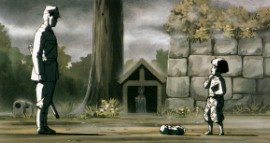 But Chika
met a military policeman on the way to the train station. But Chika
met a military policeman on the way to the train station.
The military policeman said,
"Everything from the enemy must be destroyed," and he took away the
doll.
Rain began to fall. The raindrops hit the
doll's face, and it looked like both Martha and Chika were crying.
Kota and Yoshie, who had been searching for
Chika, came running up. Mrs. Tanaka, while apologizing to the military
policeman, explained desperately, "I was told by the school that I have
responsibility for that doll and must take care of her. Therefore, please pass
the doll, doll to me."
Upon hearing this, the military policeman let
go of the doll without saying anything and went away.
Chika asked while crying, "Why can't
I be friends with a Blue-eyed Doll when there is a war?"
Translated from
Japanese
web page.
Return to
Friendship Doll Films
|
